How to make Traditional Hath Maluwa Up Country Style
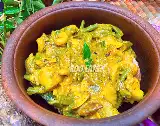 Sri Lankan New Years is filled with great and tasty foods but it can be
very oily, carby, and sugary. This 7 types of Vegetable Curry,
also known as the Hath Maluwa, is an important part of the New Years food table and
it is a healthy meal to eat during New Years that even the villagers from yesteryear knew about.
Sri Lankan New Years is filled with great and tasty foods but it can be
very oily, carby, and sugary. This 7 types of Vegetable Curry,
also known as the Hath Maluwa, is an important part of the New Years food table and
it is a healthy meal to eat during New Years that even the villagers from yesteryear knew about.

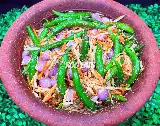 Sinhala Achcharu is a traditional condiment of pickled vegetables and it is an important food
for Sri Lankan New Years. Traditionally, it was prepared 4 days ahead using raw vegetables but today
many people boil the vegetables first. In this recipe, we add 2 additional ingredients to make it tastier.
Sinhala Achcharu is a traditional condiment of pickled vegetables and it is an important food
for Sri Lankan New Years. Traditionally, it was prepared 4 days ahead using raw vegetables but today
many people boil the vegetables first. In this recipe, we add 2 additional ingredients to make it tastier. 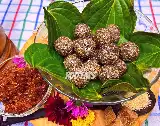 Aggala is a traditional sweetmeat made from Sesame Seeds and Jaggery for Sri Lankan New Years.
Although regular Aggala does not have a filling, to make it tastier, we added a Pani Pol filling.
You can also add Kotta Pol or just grated Coconut if you like.
Aggala is a traditional sweetmeat made from Sesame Seeds and Jaggery for Sri Lankan New Years.
Although regular Aggala does not have a filling, to make it tastier, we added a Pani Pol filling.
You can also add Kotta Pol or just grated Coconut if you like. 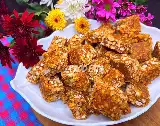 Pani Kaju is a hard and crunchy sweet that is made
from Peanuts and syrup and it is a favorite amongst old and young people
in Sri Lanka. You only need 3 ingredients to make this. This is similar to
Peanut Brittle and Peanut Praline.
Pani Kaju is a hard and crunchy sweet that is made
from Peanuts and syrup and it is a favorite amongst old and young people
in Sri Lanka. You only need 3 ingredients to make this. This is similar to
Peanut Brittle and Peanut Praline. 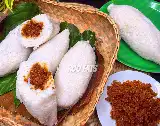 Imbul Kiribath is a traditional breakfast paddy farmers would take
with them when they go to work in the fields. The entire village would help
with paddy farming and this Imbul Kiribath would be shared amongst them.
Imbul Kiribath is Milk Rice that contains a Pol Pani filling
which is made by combining grated Coconut and Caramelized Sugar.
Imbul Kiribath is a traditional breakfast paddy farmers would take
with them when they go to work in the fields. The entire village would help
with paddy farming and this Imbul Kiribath would be shared amongst them.
Imbul Kiribath is Milk Rice that contains a Pol Pani filling
which is made by combining grated Coconut and Caramelized Sugar. 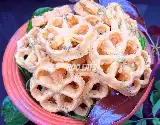 Kokis is a traditional crispy and crunchy sweetmeat made from Rice Flour
for special occasions like Sri Lankan New Years. Traditional Kokis
does not require Wheat Flour or Eggs and it is prepared only with Rice Flour.
This recipe will yield 37 Kokis which you can keep for up to 1 month.
Kokis is a traditional crispy and crunchy sweetmeat made from Rice Flour
for special occasions like Sri Lankan New Years. Traditional Kokis
does not require Wheat Flour or Eggs and it is prepared only with Rice Flour.
This recipe will yield 37 Kokis which you can keep for up to 1 month. 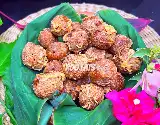 Godapara is a traditional rasa kawili that contains a moist filling
made from Pittu and an outer shell made with Rice Flour. This sweetmeat is made for
New Years in villages in Sri Lanka but most people today do not know about it.
It looks like Narang Kawum but
the filling and how it is prepared is different.
Godapara is a traditional rasa kawili that contains a moist filling
made from Pittu and an outer shell made with Rice Flour. This sweetmeat is made for
New Years in villages in Sri Lanka but most people today do not know about it.
It looks like Narang Kawum but
the filling and how it is prepared is different. 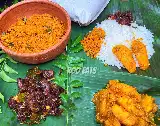 Kesel Kole Rice was a prepared rice meal that was wrapped in a banana leaf and taken on long journeys.
The Kesel Kole Rice meal will stay fresh for at least 1 day because of the way it was prepared which
involved cooking the rice and side dishes until all the moisture has gone.
Kesel Kole Rice was a prepared rice meal that was wrapped in a banana leaf and taken on long journeys.
The Kesel Kole Rice meal will stay fresh for at least 1 day because of the way it was prepared which
involved cooking the rice and side dishes until all the moisture has gone. 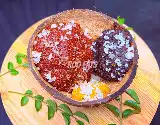 Traditional Curry Powder is a unique and important ingredient in cooking in Sri Lankan villages
and it was made fresh weekly. Traditional Curry Powder is actually a paste (called "Pahe Guli" in Sinhala)
and it comes in 3 types which are stored in a Coconut Shell (called "Pahe Pol Katta" in Sinhala).
Traditional Curry Powder is a unique and important ingredient in cooking in Sri Lankan villages
and it was made fresh weekly. Traditional Curry Powder is actually a paste (called "Pahe Guli" in Sinhala)
and it comes in 3 types which are stored in a Coconut Shell (called "Pahe Pol Katta" in Sinhala). 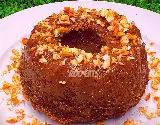 Watalappan is a sweet steamed coconut custard pudding that is an important part of Sri Lankan cuisine.
While traditional Watalappan uses Coconut Milk and Jaggery, this easy Watalappan recipe
uses only 3 ingredients and the taste and texture is
the same.
Watalappan is a sweet steamed coconut custard pudding that is an important part of Sri Lankan cuisine.
While traditional Watalappan uses Coconut Milk and Jaggery, this easy Watalappan recipe
uses only 3 ingredients and the taste and texture is
the same.